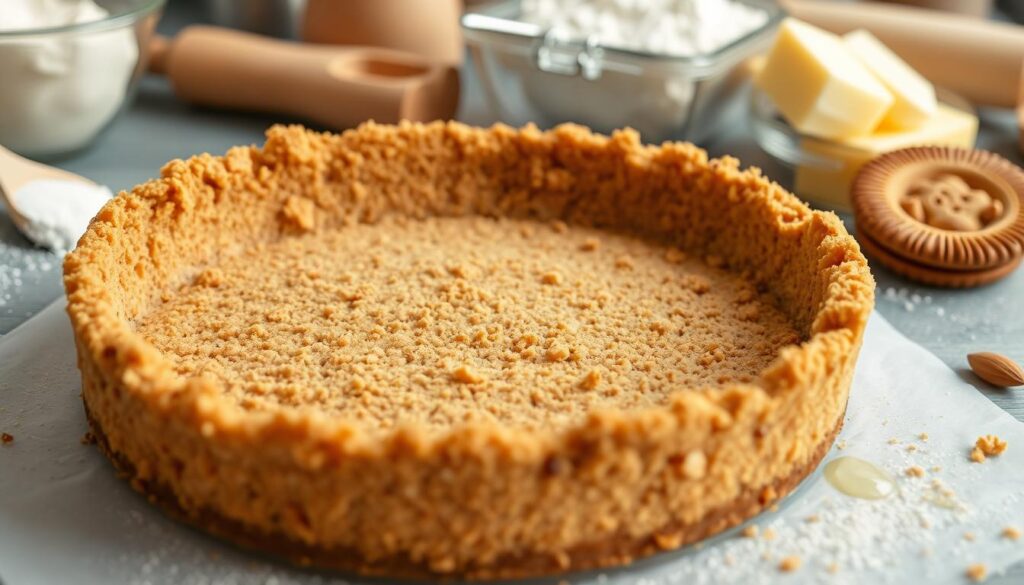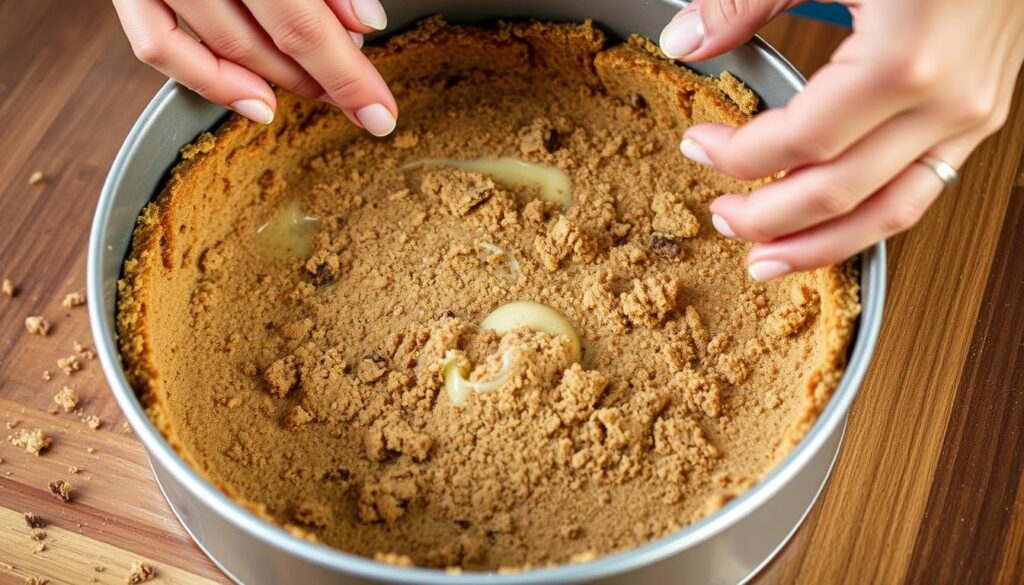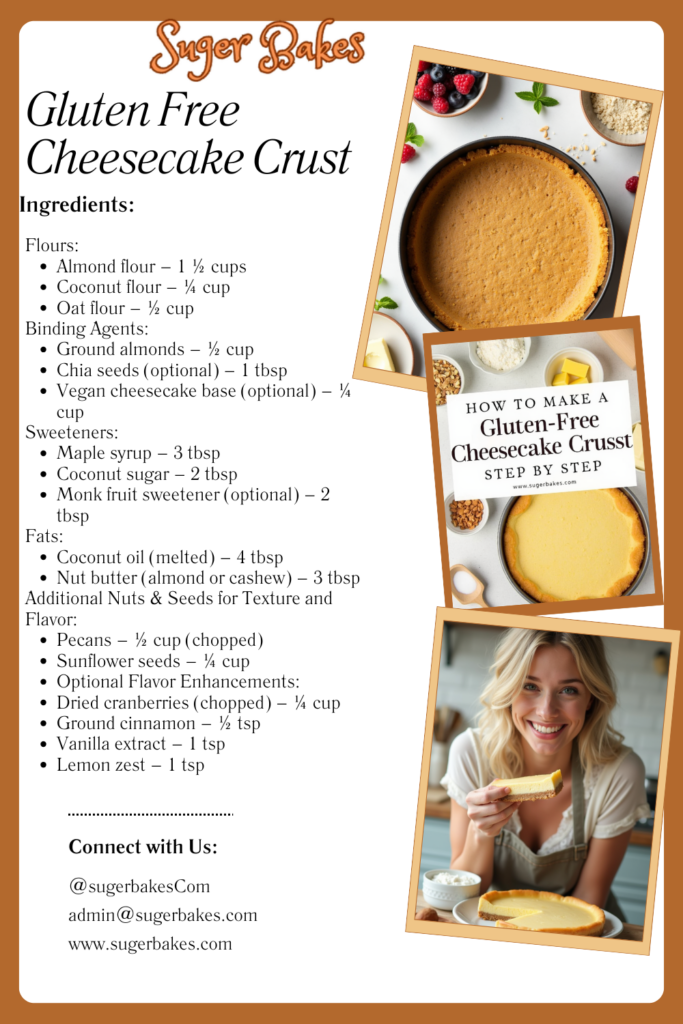
How to Make a Gluten Free Cheesecake Crust Step by Step
Table of Contents
Living gluten-free doesn’t mean you can’t enjoy a creamy, rich cheesecake. With the right ingredients and techniques, you can make a gluten-free cheesecake crust. This guide will show you how to make a perfect gluten-free cheesecake crust. You’ll learn about the key ingredients and how to bake and shape it.
Understanding Gluten Free Cheesecake Crust Basics
Creating a gluten free cheesecake starts with the crust. It’s key to use the right ingredients and tools. This will make your dessert stand out.
Common Gluten Free Ingredients
There are many flours for gluten free baking. Almond flour adds a nutty taste, while graham cracker substitute offers versatility. Trying different ingredients can lead to exciting flavors and textures.
Benefits of Homemade Crusts
Making your own crust is better than buying one. It lets you control the taste, texture, and healthiness. This way, you get a dessert that’s truly yours.
Essential Equipment Needed
To make a great gluten free crust, you need some tools. A food processor or blender is crucial for the right texture. A springform pan makes the cheesecake easy to remove. And a tart tamper or spoon helps shape the crust evenly.
| Essential Equipment | Purpose |
|---|---|
| Food Processor or High-Powered Blender | Achieve the ideal crumb texture for your crust |
| Springform Pan | Facilitate easy removal of your cheesecake |
| Tart Tamper or Spoon | Press the crust into the pan for a smooth, even surface |
Knowing the right ingredients, benefits, and tools is key. Now, you’re ready to make a gluten free cheesecake crust that will wow everyone.
Best Alternative Flours for Your Crust
Choosing the right flour is key in gluten-free baking. It affects the texture and taste of your cheesecake crust. Explore different flours to find the perfect nut-based crust recipe that will impress your taste buds.
Almond flour is a top pick for cheesecake crusts. It’s made from ground almonds, giving a nutty flavor and a tender texture. Its high fat content also helps the crust stick together, making it great for gluten-free baking.
Coconut flour is another great choice. It’s made from dried coconut meat, adding a sweet and toasted flavor. But, it absorbs a lot of liquid, so you’ll need to adjust your recipe’s liquid content.
Oat flour is perfect for a heartier crust. It’s ground oats, offering a nutty taste and a chewy texture. Make sure to use gluten-free oats to keep your crust gluten-free.
| Flour Type | Flavor Profile | Texture | Binding Properties |
|---|---|---|---|
| Almond Flour | Nutty | Tender, Crumbly | Excellent |
| Coconut Flour | Lightly Sweet, Toasted | Dense, Absorbent | Good |
| Oat Flour | Nutty | Chewy | Good |
Try out these flours to make a nut-based crust that’s just right for your gluten-free cheesecake. Each flour has its own special qualities. By knowing these, you can make a crust that’s just what you like.
Essential Ingredients and Substitutions
Making a gluten-free cheesecake crust needs careful thought. You must pick the right ingredients for texture and taste. Learn about the key parts and how to swap them for dairy-free and vegan options.
Binding Agents and Their Roles
Binding agents keep the crust together, giving it structure and preventing it from crumbling. You can use ground nuts, seeds, or dairy-free alternatives like vegan cheesecake base. These not only help the crust stick together but also add flavor.
Sweetener Options
- Maple syrup or honey for a natural sweetness
- Coconut sugar or date sugar for a deeper, caramel-like flavor
- Erythritol or monk fruit sweetener for a low-calorie, dairy-free option
Fat Choices for Perfect Texture
The fat in the crust affects its texture. Choose vegan fats like coconut oil, avocado oil, or nut butters for a creamy feel. These fats also add nutritional value.
Knowing the importance of these ingredients and finding dairy-free and vegan swaps lets you make a gluten-free crust that’s both tasty and inclusive.
Preparing Your Gluten Free Cheesecake Crust
Making the perfect gluten free cheesecake crust is key to a great dessert. You can choose between a baked or no-bake crust. Both need careful steps to make a smooth base for your cheesecake.
Measuring and Mixing the Crust Ingredients
First, measure your gluten free flour, binders, sweeteners, and fats carefully. Right amounts are vital for the right taste and texture. Mix the dry ingredients well, then add the wet ones like melted butter slowly. This will make a dough or crumb mixture.
Handling the Dough or Crumbs
For a baked crust, press the dough into your pan evenly. Make sure it’s even and goes up the sides. For a no-bake cheesecake crust, just press the mixture into the pan. Use your fingers or a tool to make it smooth.

Chilling and Baking the Crust
If you’re baking, put it in the oven until it’s golden. Let it cool before filling. For no-bake, chill it in the fridge for 30 minutes. This will make it firm for your filling.
By following these steps, you’ll make a stunning gluten free cheesecake. Your crust will be perfect for the creamy filling.
Mastering the Perfect Texture and Consistency
Getting the right texture and consistency for your gluten-free cheesecake crust is key. It’s all about the right mixing, temperature, and solving common problems. This way, you can make a crust that goes well with the creamy filling.
Proper Mixing Techniques
The secret to a great graham cracker substitute crust is in the mix. Mix the dry ingredients, binding agents, and fats gently. This keeps the crust from getting too hard or crumbly.
Temperature Considerations
Temperature is crucial for a successful gluten-free crust. Make sure your ingredients are at room temperature before mixing. Also, watch the baking temperature and time to get the crust just right.
Troubleshooting Common Issues
- If your crust is too dry or crumbly, add more binding agent or fat.
- For a dense or tough crust, use a lighter flour or more airy ingredients.
- If the crust bakes unevenly, adjust the oven temperature or pan position.
By learning these techniques and fixing common problems, you can make a gluten-free baking masterpiece. Your crust will perfectly match the cheesecake’s flavors and textures.
Tips for Pressing and Shaping the Crust
Mastering the art of pressing and shaping your gluten free cheesecake crust is key. It ensures your dessert looks and tastes great. Whether you’re using an almond flour crust or another gluten-free option, these tips will help you achieve a professional look.
First, make sure your crust mixture is well-combined and the right consistency. It should be easy to work with but not too sticky or crumbly. Press the mixture into your pan, starting from the center and moving outwards. Use your fingers or a spoon to smooth out the surface.
To get a neat crust, use a flat-bottomed glass or measuring cup. This helps press the crust evenly into the pan. It also ensures a smooth base for your cheesecake filling.
- Lightly grease the pan or line it with parchment paper to prevent sticking.
- Work in small increments, pressing the crust a little at a time to ensure even distribution.
- Use your fingertips to gently pinch and shape the crust up the sides of the pan, creating a clean, straight edge.
- If the crust becomes too soft or sticky, chill it in the refrigerator for 15-20 minutes before continuing to shape.
Remember, the key to a perfect gluten free cheesecake crust is patience and attention to detail. With a little practice, you’ll be shaping beautiful, professional-looking crusts in no time.

| Technique | Benefits |
|---|---|
| Using a flat-bottomed glass or cup to press the crust | Helps create a smooth, even base for the cheesecake filling |
| Chilling the crust before shaping | Firms up the mixture, making it easier to work with and shape |
| Gently pinching and shaping the crust up the sides of the pan | Produces a clean, professional-looking edge for the cheesecake |
Baking and Cooling Guidelines
Making a gluten-free cheesecake crust is a delicate task. It needs careful baking and cooling. Follow these tips to get a crust that’s crisp, tasty, and pairs well with your cheesecake.
Pre-baking Instructions
Pre-baking, or blind baking, is key for a strong gluten-free crust. Here’s how to do it:
- Preheat your oven to 375°F (190°C).
- Press your crust mixture into a greased or parchment-lined springform pan. Make sure it’s even and reaches the edges.
- Use a fork to prick the crust several times. This prevents air pockets during baking.
- Bake the crust for 12-15 minutes, until it’s lightly golden and set.
- Let the crust cool completely before adding your cheesecake mixture.
Storage Recommendations
Storing your gluten-free cheesecake crust right is important. Here are some tips:
- Store the cooled crust at room temperature for up to 3 days. Wrap it tightly in plastic wrap or foil.
- For longer storage, freeze the crust for up to 3 months. Wrap it tightly in plastic wrap or foil, or use an airtight container.
- Thaw the frozen crust at room temperature before filling and baking your cheesecake.
By following these baking and cooling tips, you’ll make a perfect gluten-free cheesecake crust. It will enhance your dessert beautifully.
“The secret to a great gluten-free crust is in the pre-baking and proper storage. Take the time to get these steps right, and your cheesecake will be a hit!”
Creative Variations and Flavor Enhancements
Make your gluten-free cheesecake crust stand out with creative twists. Whether you love a nut-based crust or a vegan base, there are many ways to enhance it. Your crust can be truly unique and delicious.
Try different nuts and seeds for a new taste. Swap almonds or pecans for hazelnuts, walnuts, and sunflower seeds. This mix adds depth and texture, exciting your taste buds.
Add dried fruits like apricots, figs, or cranberries for sweetness. Their natural sugars blend well with the nuts, creating a perfect flavor balance.
- Spice things up with cinnamon, cardamom, or ginger for a cozy twist.
- Use vanilla bean or extract for a warm aroma.
- Try citrus zest, like orange or lemon, for a refreshing touch.
For a vegan crust, explore plant-based options. Use cashews, coconut, or avocado for a creamy base.
| Ingredient | Purpose | Suggested Substitutions |
|---|---|---|
| Nuts | Provide texture and flavor | Almonds, pecans, walnuts, hazelnuts, cashews |
| Binders | Hold the crust together | Dates, chia seeds, flaxseeds, ground oats |
| Sweeteners | Add natural sweetness | Maple syrup, honey, coconut sugar, dates |
| Fats | Create a rich, smooth texture | Coconut oil, nut butters, avocado |
With creativity and experimentation, your gluten-free cheesecake crust can be amazing. Explore new flavors and let your taste buds guide you.
“Baking is like painting or dancing. It’s an art, and it takes time, practice, and a touch of magic to get it just right.”
Conclusion
In this guide, we’ve covered gluten-free cheesecake crusts. You now know how to make a tasty, homemade treat. You’ve learned about gluten-free baking and how to get the right texture.
Whether you bake for dietary needs or just want something tasty, this article helps. It shows you how to succeed in gluten-free baking. The secret to a great crust is to be open to trying new things and having fun.
Start exploring gluten-free baking and let your creativity flow. Make gluten-free cheesecake crusts that are both delicious and healthy. With practice, you’ll make desserts that everyone will love.

FAQs About Gluten-Free Cheesecake Crusts
What are some common gluten-free ingredients used for cheesecake crusts?
What are the benefits of making a homemade gluten-free cheesecake crust?
What essential equipment is needed to make a gluten-free cheesecake crust?
How do I choose the best alternative flour for my gluten-free cheesecake crust?
What ingredients are important for binding and structuring a gluten-free cheesecake crust?
How do I properly prepare and press the gluten-free cheesecake crust into the pan?
What techniques ensure the perfect texture and consistency for a gluten-free cheesecake crust?
How should I bake and cool the gluten-free cheesecake crust?
Can I customize the flavor of my gluten-free cheesecake crust?
Share Your Experience with Our Recipe!
There are no reviews yet. Be the first one to write one.



